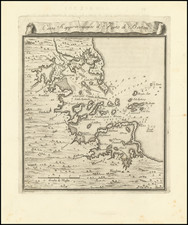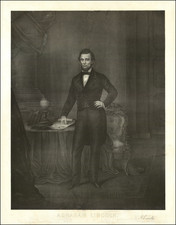Nice example of John Trumbull's iconic view of the Death of General Warren at Bunker Hill.
Engraved by J.C. Muller and published by A.C. de Poggi in London, this iconic engraving depicts the death of General Warren at the Battle of Bunker's Hill, June 17, 1775, based upon an oil painting by the American artist John Trumbull. Warren, an influential Massachusetts politician, had been commissioned a general, but served in the battle as a volunteer. He was killed during or shortly after the storming of the redoubt atop Breed's Hill by British troops.
Warren is depicted in his final moments, cradled by a fellow American militiaman who valiantly attempts to ward off an English soldier's bayonet. This scene is further dramatized by the intervention of British Major John Small, who is seen restraining his soldier's bayonet. Surrounding them are notable figures: Americans Captain Thomas Gardner, Major Andrew McClary, and Colonel William Prescott, all vigilantly defending their fallen leader. In a poignant juxtaposition, British Major John Pitcairn, fatally injured, is supported by Lieutenant William Pitcairn, while to the right, American Lieutenant Thomas Grovesnor stands guard over an armed African American, commonly believed to be Peter Salem, reputed for his alleged role in Pitcairn's death. However, historical accuracy suggests this figure is more likely Grovesnor's enslaved man.
The background of the scene is filled with key participants of the battle, adding depth to the historical narrative. British Generals William Howe, Henry Clinton, and Lieutenant Francis Lord Rawdon are depicted pressing forward in the heat of battle, their determination evident. Other American soldiers, such as Colonel Israel Putnam, heroically leading the retreat, Rev. Samuel McClintock, Major Willard Moore, and potentially Peter Salem, are also included, contributing to the rich tapestry of this momentous event. American Lieutenant Colonel Moses Parker and British Lieutenant Colonel Sir Robert Abercromby are portrayed in their final moments, underscoring the widespread tragedy of the conflict.
The painting is one of the iconic images of the American Revolution. Trumbull painted several versions of the subject, including the one in the Museum of Fine Arts, Boston (dated between 1815 and 1831), which was commissioned by the Warren family and passed down through the family. He sold the engraving rights for this painting and The Death of General Montgomery in the Attack on Quebec, December 31, 1775, for a highly successful subscription release that greatly enhanced his career.
Trumbull, son of the Governor of Connecticut, was uniquely qualified to paint scenes of the American Revolution, as he served in the Continental army during the war and knew first-hand the characteristics of the American and British armies and the nature of this conflict. He also knew many of the participants of the Revolution and so was able to hear first-hand those events he did not himself participate in. During the battle of Bunker's Hill, Trumbull was stationed in Roxbury, on the far side of Boston from Charlestown, whence he could hear the sounds of the battle.
John Trumbull is perhaps best known as having served as an aide to George Washington during the American Revolutionary War. He then travelled to London to study painting. He is best known for his portrait paintings of George Washington and the large murals that he painted of the American Revolution, which hang in the rotunda of the U.S. Capitol.
Trumbull began with a painting of "The Death of General Warren at Battle of Bunker's Hill" in the fall of 1785, finishing it the follow March. This canvas was called by Benjamin West "the best picture of a modern battle that has been painted", and it was well received by those who viewed it in West's studio. Trumbull had absorbed the style and form of West's work, but added to this his own personal knowledge of the individuals and the military dress, weapons and events of the time. Through West, Trumbull met Antonio di Poggi, an artist and print publisher, who agreed to publish the prints for a share of the profits. They decided to look in Paris for an engraver, as no British engraver would dare to do the work on this subject matter. They searched through the summer and early fall of 1786 in Paris and then Frankfurt, with no success. When Trumbull returned to London in October 1786, Poggi kept the paintings to continue to look for an engraver. Poggi finally found Johann Gotthard von Müller, an engraver from Stuttgart, who agreed in July 1788 to undertake the engraving of Trumbull's Bunker Hill.
In 1789, Trumbull sailed to America to work on promoting the sale of his forthcoming prints. At this stage the engraving by Müller was not progressing very fast. Trumbull tried to market his prints when he arrived and awaited proofs, which Poggi promised to send as soon as they were pulled, to show potential subscribers. In 1795, Trumbull visited Stuttgart and was satisfied with the progress Müller was making. Finally in July 1797, Trumbull heard from Müller that the plate was finished.










![[ United States General ] Etats-Unis 1863 General (Abraham Lincoln?)](https://storage.googleapis.com/raremaps/img/small/103135.jpg)
![For Governor, Maj. Gen. John W. Geary [Former Mayor of San Francisco / Governor of Kansas Territory and Governor of Pennsylvania]](https://storage.googleapis.com/raremaps/img/small/93592.jpg)
![(American Revolution) [Manuscript Map of New York City and Northern New Jersey]](https://storage.googleapis.com/raremaps/img/small/69609.jpg)

